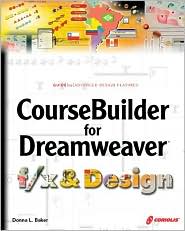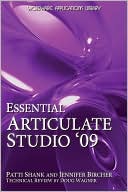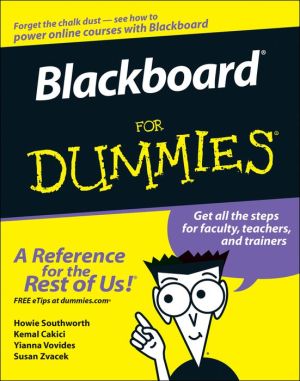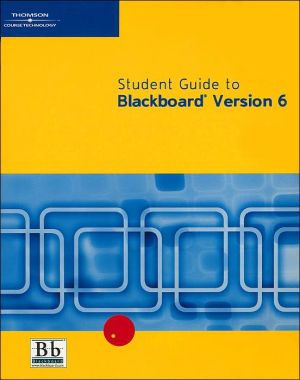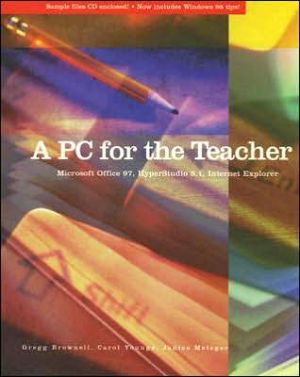CourseBuilder for Dreamweaver f/x & Design
CourseBuilder for Dreamweaver f/x and Design discusses how CourseBuilder works easily and effectively with Dreamweaver and other similar Web page and Web site design programs. It explores the various types of interactions available for online training with emphasis on correlating and coordinating CourseBuilder elements with the rest of a Web site. Two appendices covering Extensions and Platform and Server Requirements, real-world projects that illustrate and exemplify Coursebuilder's...
Search in google:
CourseBuilder for Dreamweaver f/x and Design discusses how CourseBuilder works easily and effectively with Dreamweaver™ and other similar Web page and Web site design programs. It explores the various types of interactions available for online training with emphasis on correlating and coordinating CourseBuilder elements with the rest of a Web site. Two appendices covering Extensions and Platform and Server Requirements, real-world projects that illustrate and exemplify Coursebuilder's features, and a CD-ROM filled with extensions, project files and graphics, and demo versions of several Macromedia products are added bonuses to this wonderful book.
Chapter 2: Who Uses CourseBuilder?\ CourseBuilder can be many things to many people. \ What's the secret to knowing what it is to the people \ you are building projects for? Understanding who your audience is and what they want and need. Answer the "Who? What? Why?" questions before tackling CourseBuilder's answers to "How?" \ Who Is My Audience?\ First and foremost, who are you designing your project for? And don't answer "everybody." Only those special people with a particular brand of egomania are arrogant enough to define their audience as everybody in the world with access to your material.\ Even if you are creating a training, testing, or learning module for a widely diverse audience, it is still necessary to describe your users' characteristics. As you will see through the course of this book, specific audiences, once defined, almost tell you what you have to do to meet their learning needs.\ I won't go into a long discussion here about instructional design. This book is not the forum for that, nor is that my area of expertise. I have included a list of URLs for this type of information in Appendix A. Browse and discover to your heart's content.\ Like everything else in modern life, audiences for your work are generally analyzed, studied, and assigned characteristics. Find out what those characteristics are. How, you ask? Well, based on the environment your project will appear in, of course.\ Demographics\ Yes, I know what graphics are, and what computer graphics are, but demographics? This is simply (or not so simply!) the description of a particular user or group of users. These descriptions include both personal and socioeconomic characteristics. Regardless of whether the user is a consumer of commercial housecleaning products or the consumer of first-grade matching games, all users share a large number of characteristics. The key to building your projects in a way that appeals to the users of your product is understanding them. And the more you have identified your users' needs and characteristics, the easier it is for you to do the work.\ Again, this is not a laborious or extensive discussion of demographics; Appendix A offers a list of URLs you can use.\ Basic Characteristics\ A number of basic characteristics exist that you can readily define for your audience. Here is a short mental exercise. Read these descriptions and see what characteristics come to mind:\ \ Boy in kindergarten\ Young, stay-at-home mother with a toddler and a newborn\ Forty-something accountant with a wife, a teenager, and a mortgage\ \ What did you think when you read each of these lines? Thought so. You are well on your way to defining your audience. Let's look at each of the following simple descriptions briefly.\ How do you describe a boy in kindergarten? The word tornado comes to my mind! But what else—short attention span, active, playful, colorful, busy,\ inquisitive, magical.\ The young mother? Conscientious, careful, tired, baby-centered, giving, caring, and did I mention tired?\ Finally, the accountant. Responsible, concerned, future-planning, hard-working, stable, diligent.\ Why Do I Need This Information?\ The point of this exercise is to have you begin to understand who you are creating your project for. The more you know about your audience, the easier it is to design projects that appeal to them specifically. Let's look at some of the social and economic characteristics of each of our subjects.\ Timmy, the Kindergarten Boy\ First, Timmy the kindergarten boy. Probably he has no financial assets. However, he does possess one extremely important financially related characteristic—the ability to influence. Don't think those Saturday morning cartoons are annoying? Try having them around the house when a member of their target market is present. As we have seen in the past few years, there is a substantial blurring between the shows' content and the advertisements. This is done very specifically, as millions of parents with holiday wish lists can attest to. And, if you are planning a learning product for this specific age group, you had best pay heed as well. Appeal to the list of characteristics we defined earlier.\ Sue, the Stay-at-Home Mom\ Next comes Sue the young mother. She is at the beginning of her motherhood career. Economic characteristics may vary here, but I am sure there are a number of social characteristics that this particular audience will have in common. Her life is baby-centric. She has made raising her family a career choice. Therefore, like anyone making a career choice, all the elements that support that choice are important. She will probably be interested in specific types of products that will either enhance her experience as a mother, contribute to the growth and development of her children, or make running her household more efficient and effective. Think cleaning products, disposable diapers, and super-absorbent paper towels. From the perspective of her maintaining some sense of self, don't forget things like moisturizing bath wash and two-in-one shampoo (for that silky hair with a minimum amount of fuss). In Sue's case, fuss equates to time, of course.\ Terry, the Accountant\ Finally, Terry the accountant. Socially responsible, economically stable. In his forties. Working hard, well into the groove of his chosen profession. But thinking about retiring at some point. Stable family life (well, as stable as teenagers will allow). What will appeal to him? It's probably safe to say it isn't little brightly colored characters blathering at one another. Nor is it likely to be blindingly white laundry. No sirree. What Terry is interested in is stability, protecting what he has, and maybe some big-boy toys. Depending on the time of year, that may be investment strategies or a new Honda Valkyrie.\ A Few More Words about Audiences\ How many audiences are there? Short answer—as many as you would like to define, and as many as you need. Again, to borrow a marketing idea. An audience can be defined to excess. Here is an extreme example—Timmy is part of a market segment of five- to six-year-olds in a demographic group consisting of double-income two-parent families with one child living in cities in the Midwest having populations between 400,000 and 600,000 who live in a single detached home with a value of $130,000 to $150,000 and an annual family income of $70,000 to $75,000. Boys in Timmy's particular group have brown hair and green eyes, have been on an airplane at least once, and have been on a family vacation at least twice.\ Primary Audiences\ Based on this analysis, you might end up with a few dozen Timmy-like boys. This demographic segment is far too small to be useful. We have to back up.\ Suppose you are designing a CourseBuilder project for a kindergarten-age child. What, if anything, do you need to know about this audience from an economic perspective? Basically, the only factor that will have any influence will be the average child's exposure to the elements you are using in your project design. For example, if you design a matching game using images of items the child has no experience with, there will be no point either to the building of the project or its use. A child who has never seen snow might have no idea that mittens and scarves are a match.\ For some audiences, economic and social characteristics are going to be the most important focus for your efforts. Consider Sue and Terry. It would be impossible, not to mention pointless, to define them physically. It wouldn't matter if Sue were 23 or 33. If you were designing a project dealing with high-priced learning toys, her level of education and disposable income might be important factors.\ Nor would it make much difference whether Terry was an accountant, a banker, or a computer programmer. It is much more useful to spotlight what motivates him, and then appeal to that.\ Secondary Audiences\ To confuse the issue further, we also have to consider secondary audiences. In Timmy's case, his parents would be a secondary audience controlling his access to materials on the basis of whether they feel it is appropriate, constructive, or useful for him. As adults, Sue and Terry don't have the same access issues, but other influences will still be important.\ Sue's secondary audience could be a significant other—spouse and/or other relative, or friends. In Terry's case, his family would be a likely source of influence. I rather doubt that a shiny new black motorcycle would find a happy home if his wife were dead set against it! Another source of influence for him would probably be his peer group and work associates.\ In the case of most of the projects in this book, we will be concerned primarily with primary audiences, except in the case of projects designed for children. Bear in mind, for future reference, that other audiences can influence those you are designing for.\ Now What?\ Well, this book is entitled "CourseBuilder," so let's get to it. I think understanding the idea of audiences will assist you in making design and build decisions. One last set of examples. Again, we will use Timmy, Sue, and Terry.\ Look at the three images shown as Figure 2.1, Figure 2.2, and Figure 2.3. Each is a representation of a Web page that will house a CourseBuilder project. Which page was designed for which person representing which group?\ At first glance, it is pretty obvious. And that is my point. Each is designed from the perspective of the user group. Understanding who is going to view your work and what they need to be able to understand it, interact with it, and learn from it are vital to producing a good product—which is why you are reading this book in the first place.\ Determining Project Objectives\ Let me reassure you that I will not be going into a huge discussion of project planning and management at this point. Had you worried there for a minute though, didn't I? I do, however, want to introduce the process that I use. It is manageable, flexible, and above all practical. As we move through the book, I will be using my Design Document process to introduce a number of projects and case studies, to give them some context. If you are one of those rare souls who reads this book cover to cover (and there must be at least one!), you will have plenty of opportunity to see how it works in practice. For the majority of readers who nibble through a book in chunks, the process will still be apparent without having read this discussion.\ Step 1: A Project Must Have Objectives\ A project must have objectives. That sounds like a good idea, but what does it mean? Regardless of whether you are building a Web-based training vehicle or a sports utility vehicle, an objective is the same. It is a statement. An objective must be measurable, it must have defined goals, it must be quantifiable, and it must have a time frame. So, for example, if we were designing a college training module that is used to introduce students to how combustion engines work, we would have to define both learning objectives and design objectives. We can define our learning objectives thusly (I like that word):\ "At the completion of this module, the student will have an introduction to the combustion engine. The student will be familiar with the components of the engine, be introduced to the process of combustion, and have an overview of the relationships between the parts."\ Because we are dealing with a design process, we must consider design objectives as well:\ "To build and test a Web-based training module that will demonstrate the function of a combustion engine. The module will have a 5-question pretest, a 10-slide introductory lesson component with 3 self-assessment question screens, and a 10-question post-test. The project will be based on materials found in the Introduction to Combustion Engines course, Chapters 1–2. Project timeline is 2.5 weeks."\ In ordinary circumstances, I would probably start with the learning objectives, and then I would build design objectives as required during the planning of the whole course. In this example I defined the design objectives only for the CourseBuilder component. In practical terms, as you will see in a moment, it is still simplest to start from the learning objectives.\ Step 2: Use The Objectives to Define Learning and Design Goals\ Let's look again at the learning objectives in this example. The statements I wrote can be broken into four separate statements:\ \ Introduction to combustion engine (the overall objective)\ Familiarity with components\ Introduction to combustion process\ Overview of relationships between parts\ \ What we now have are three separate learning goals based on one overall objective.\ And what of the design goals? Again, they will relate to the objectives we have just outlined. The design example is based on a structured design process in that the different components are predefined. The pretest, the lesson with self-testing, and the post-test are an example of a standardized format. Which contrasts wildly with this example: "Build me something; it has to be good; it has to work; and I need it in a week." That, ladies and gentlemen, was an actual quote from my past. My project was good, it did work, it was done to deadline, and it was something else! Perhaps more reflective of corporate life than academic life.\ Step 3: Break Down the Goals into Specific Tasks and Steps\ This learning process then breaks down into smaller steps, where we define each segment of each goal. This whole definition process can best be explained visually, as shown in Figure 2.4.\ As you can see here, we basically have a pyramid. At the apex is the overall objective, then the specific learning objectives, then the topics that make up that objective. From this point, individual pieces of information will be developed, again relating to how much emphasis is placed on that objective.\ The same process will follow through to the testing component of this module. For example, if there are 10 questions in the post-test, perhaps 1 question would be based on an "overview" topic, as opposed to 2 or 3 for a "familiar with" topic.\ Choosing the Right Tools\ As with everything in life, you have to use the right tools for the job. CourseBuilder provides a tidy little toolbox. How you use its tools is up to you. With my guidance, however, I hope you will not be using a screwdriver to bang in a nail.\ Right Information\ We have already discussed applying a process to determine the information you will use in your CourseBuilder project. I have a few more suggestions for some particular circumstances.\ \ My example included a pretest, intermittent self-tests throughout the lesson, and then the final testing. Do you need all these elements? Consider the benefits gained by each of these efforts prior to committing the resources to their development. For example, if you are creating an orientation package for new staff, a pretest might be redundant. On the other hand, you must include a pretest if the project is designed to branch to different types of information and training based on the outcome of the pretest.\ A common event nowadays is to move training from a traditional classroom to a Web-based one. It is not simply a matter of converting material to an HTML format. For one thing, reading from a screen is different than reading from a page. In a classroom, a good trainer will distill the information provided in manuals and texts and discuss the important issues and concepts. This same process should be considered when moving material to the Web. Some materials might require condensing or expanding.\ Whenever you assume prior knowledge exists, make sure you are correct. You might need to provide additional training. This is one area where you might want to include a pretest or proof of knowledge such as certification or completion of other training.\ Another trend is to create training nuggets. Consider a box of chicken nuggets from your favorite fast food emporium. You may need one nugget or two or the whole box of twelve. You may need barbecue sauce or sweet and sour sauce. So it is with training nuggets. Training nuggets are designed to be consumed on an as-required basis, either individually or as a group of elements. Each is designed as a standalone element that provides training and testing on a particular element of a process or task. A more formal analogy is to compare training nuggets to objects used in object-oriented programming. Each object is a standalone object that can be used and reused either singly or in combination with other objects.\ \ Information Constraints\ Your work probably won't be developed in a vacuum but will have to conform to any number of restrictions. These can be corporate, certification, training, or training design issues. Remember the earlier discussion on the combustion engine case? Clearly, the output from that process was influenced heavily by both training and training design requirements.\ Look again at the discussion of learning nuggets. This is a good example of both corporate and training design influences on a project. Regardless of your desires to create a sweeping masterpiece of preambles, interactive media elements, lessons and tests, it all comes down to what is needed. Nuggets, not the whole bird....
ForewordForewordCh. 1Before You Begin: Requirements and Other Issues1Ch. 2Who Uses CourseBuilder?19Ch. 3Multiple-Choice CourseBuilder Interactions37Ch. 4Drag-and-Drop CourseBuilder Interactions63Ch. 5Explore CourseBuilder Interactions89Ch. 6Text Entry CourseBuilder Interactions109Ch. 7CouseBuilder Button Interaction Controls129Ch. 8Timer CourseBuilder Interactions147Ch. 9Slider CourseBuilder Interactions169Ch. 10The Action Manager189Ch. 11Advanced CourseBuilder Features219Ch. 12Using Other Media in CourseBuilder247Ch. 13Scoring and Data Tracking263Ch. 14Introduction to Learning Sites291Ch. 15Building a Learning Site313App. A: Sites of Interest337App. B: Extensions341App. C: Platform and Server Requirements351App. D: Project Design Template361Index365
